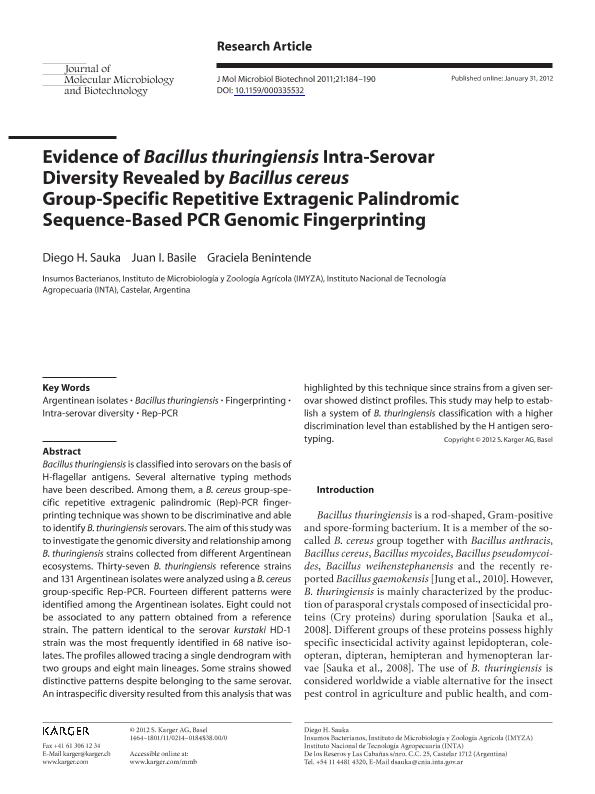Mostrar el registro sencillo del ítem
dc.contributor.author
Sauka, Diego Herman

dc.contributor.author
Basile, Juan Ignacio

dc.contributor.author
Benintende, Graciela Beatriz

dc.date.available
2018-07-27T18:18:08Z
dc.date.issued
2012-01
dc.identifier.citation
Sauka, Diego Herman; Basile, Juan Ignacio; Benintende, Graciela Beatriz; Evidence of bacillus thuringiensis intra-serovar diversity revealed by bacillus cereus group-specific repetitive extragenic palindromic sequence-based PCR genomic fingerprinting; Karger; Journal of Molecular Microbiology and Biotechnology; 21; 3-4; 1-2012; 184-190
dc.identifier.issn
1464-1801
dc.identifier.uri
http://hdl.handle.net/11336/53316
dc.description.abstract
Bacillus thuringiensis is classified into serovars on the basis of H-flagellar antigens. Several alternative typing methods have been described. Among them, a B. cereus group-specific repetitive extragenic palindromic (Rep)-PCR fingerprinting technique was shown to be discriminative and able to identify B. thuringiensis serovars. The aim of this study was to investigate the genomic diversity and relationship among B. thuringiensis strains collected from different Argentinean ecosystems. Thirty-seven B. thuringiensis reference strains and 131 Argentinean isolates were analyzed using a B. cereus group-specific Rep-PCR. Fourteen different patterns were identified among the Argentinean isolates. Eight could not be associated to any pattern obtained from a reference strain. The pattern identical to the serovar kurstaki HD-1 strain was the most frequently identified in 68 native isolates. The profiles allowed tracing a single dendrogram with two groups and eight main lineages. Some strains showed distinctive patterns despite belonging to the same serovar. An intraspecific diversity resulted from this analysis that was highlighted by this technique since strains from a given serovar showed distinct profiles. This study may help to establish a system of B. thuringiensis classification with a higher discrimination level than established by the H antigen serotyping. Copyright © 2012 S. Karger AG, Basel.
dc.format
application/pdf
dc.language.iso
eng
dc.publisher
Karger

dc.rights
info:eu-repo/semantics/openAccess
dc.rights.uri
https://creativecommons.org/licenses/by-nc-sa/2.5/ar/
dc.subject
Argentinean Isolates
dc.subject
Bacillus Thuringiensis
dc.subject
Fingerprinting
dc.subject
Intra-Serovar Diversity
dc.subject
Rep-Pcr
dc.subject.classification
Otras Ciencias Biológicas

dc.subject.classification
Ciencias Biológicas

dc.subject.classification
CIENCIAS NATURALES Y EXACTAS

dc.title
Evidence of bacillus thuringiensis intra-serovar diversity revealed by bacillus cereus group-specific repetitive extragenic palindromic sequence-based PCR genomic fingerprinting
dc.type
info:eu-repo/semantics/article
dc.type
info:ar-repo/semantics/artículo
dc.type
info:eu-repo/semantics/publishedVersion
dc.date.updated
2018-07-17T20:49:43Z
dc.journal.volume
21
dc.journal.number
3-4
dc.journal.pagination
184-190
dc.journal.pais
Suiza

dc.journal.ciudad
Basel
dc.description.fil
Fil: Sauka, Diego Herman. Consejo Nacional de Investigaciones Científicas y Técnicas; Argentina. Instituto Nacional de Tecnología Agropecuaria. Centro de Investigación en Ciencias Veterinarias y Agronómicas. Instituto de Microbiología y Zoología Agrícola; Argentina
dc.description.fil
Fil: Basile, Juan Ignacio. Consejo Nacional de Investigaciones Científicas y Técnicas; Argentina. Instituto Nacional de Tecnología Agropecuaria. Centro de Investigación en Ciencias Veterinarias y Agronómicas. Instituto de Microbiología y Zoología Agrícola; Argentina
dc.description.fil
Fil: Benintende, Graciela Beatriz. Instituto Nacional de Tecnología Agropecuaria. Centro de Investigación en Ciencias Veterinarias y Agronómicas. Instituto de Microbiología y Zoología Agrícola; Argentina
dc.journal.title
Journal of Molecular Microbiology and Biotechnology

dc.relation.alternativeid
info:eu-repo/semantics/altIdentifier/doi/https://dx.doi.org/10.1159/000335532
dc.relation.alternativeid
info:eu-repo/semantics/altIdentifier/url/https://www.karger.com/Article/Abstract/335532
Archivos asociados
